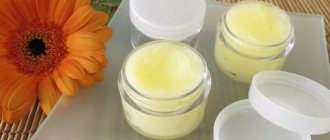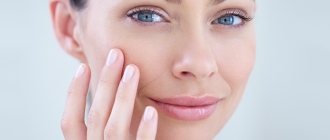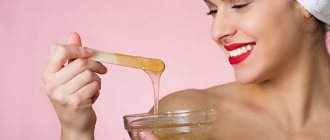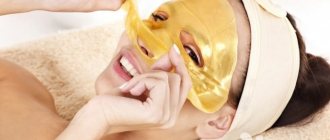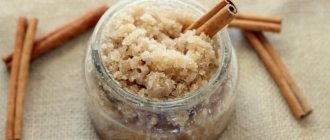Updated: 04/23/2021 11:28:27
Expert: Natalya Borisovna
The value and importance of vitamins for humans is undeniable - they are the best source of not only health, but also beauty, youth, and longevity. You can nourish the body from the inside by eating fruits, vegetables, as well as a vitamin and mineral complex.
The beauty and youth of facial skin can also be restored and preserved with the help of vitamin masks. Journalists from expertology.ru found out that such remedies can be prepared independently at home. And from products that are likely to be found in any woman’s refrigerator. Lemon, honey, banana, yeast, soda, egg, kefir, sour cream are perfect for masks. We have selected for you the 10 best recipes for vitamin face masks that can be prepared in 3 minutes.
Masks made from natural ingredients
The best recipes for vitamin face masks from ordinary products:
- A product that cleanses,
removes excess oil from the skin, and helps tighten pores. It also eliminates inflammatory processes and restores the epidermis. To prepare, you will need 1 teaspoon of baking soda and warm (not hotter than 45 degrees) honey. The components must be mixed in such proportions to obtain a plastic mass. Apply the mask to your face and wash off after 15-20 minutes. - A product that removes oily shine
, dries the skin and makes it elastic and velvety. You only need one ingredient - fresh chicken egg white. It must be separated from the yolk and applied to the face, avoiding the area around the eyes. Rinse off after 15 minutes with cool water. - Moisturizing and rejuvenating mask
for dry and combination skin made from regular halva (without nuts and other additives). Grind a small piece of halva with a fork, add water so that a paste forms. Apply to face, rinse after half an hour. - Vitamin mask for all skin types
(including problem and aging skin) made from yeast and kefir. To prepare the product, you need to take a tablespoon (or a little more) of any culinary yeast and mix with kefir to a paste. Leave for 20-25 minutes, rinse. - Revitalizing mask for oily and problem skin based on carrots
, protein and grapefruit (orange, lemon) juice. To prepare the product, you need to take small, preferably young, fresh carrots, and grind them into a puree. Beat the egg white in a separate bowl, adding freshly squeezed fruit juice little by little. Mix all ingredients and apply to face. After 20 minutes, wash off.
The best homemade vitamin recipes for facial skin turned out to be very inexpensive. And at the same time, the effectiveness of such masks is no worse than that of expensive cosmetics.
The most effective masks based on vitamin B12
B12 is a truly unique vitamin that has many beneficial properties. Firstly, it is a natural source of youth, so it is especially useful for aging skin. In addition, B12 smoothes the epidermis, moisturizes and nourishes the skin, making it elastic and smooth.
Rejuvenating mask with vitamin B12
Ingredients: 1 tsp. liquid honey, 1 tsp. sour cream, 1 tbsp. l. cottage cheese, a couple of drops of essential oil, one ampoule of vitamin B12, a couple of drops of liquid aloe extract.
Directions for preparation and use: Combine all ingredients and mix thoroughly. Apply the mixture to your face, and after half an hour, rinse with cool water. The procedure is best performed a few hours before bedtime.
Toning mask with vitamin B12
Ingredients: 1 ampoule of vitamin B12, 1 tbsp. l. kefir, lemon juice.
Directions for preparation and use: Combine all ingredients and mix thoroughly. Apply the mixture to your face and leave for 15-20 minutes. Afterwards, lightly rinse your face with water at room temperature.
Watch the video and read below about why masks with vitamins are so necessary for the beauty of our skin.
The importance of different vitamins for the skin
When you choose the best vitamin face mask recipe, you need to consider how certain vitamins act on the skin. This will help you decide on the components of cosmetics and care products. They are selected depending on what result you want to achieve.
The effect of different components of masks on the skin:
- Ascorbic acid or vitamin C. Intensifies regenerative processes in the deep layers of the skin. Helps in the prevention of acne, acne, pimples. Helps prevent skin aging and the appearance of facial wrinkles. Vitamin C improves complexion and reduces the severity of age spots. It also helps to narrow enlarged pores and increases the elasticity of the epidermis.
- Vitamin E (tocopherol) is a generally recognized antioxidant and a real vitamin of youth. Promotes the removal of toxins, refreshes, rejuvenates, restores tone, eliminates dullness and fatigue of the skin. And protects from the negative effects of the external environment. Especially in unfavorable environmental conditions. It also helps eliminate dryness and flaking of the epidermis.
- Vitamins B1, B6, B12, which are contained in bananas, help rejuvenate the skin, soothe the skin, relieve irritation and inflammation, and moisturize. They also normalize blood flow and trophism (nutrition) of tissues, stimulate cell activity.
- Vitamin A (retinol) relieves (stops) the inflammatory process and acts as an antiseptic. It also activates the natural synthesis of collagen and elastin, which allows you to effectively fight wrinkles and stretch marks on the face.
- Clay and the micro- and macroelements it contains. In addition to the fact that this substance is an excellent absorbent that promotes deep cleansing of the epidermis, clay also nourishes the skin with useful biologically active substances. As a result, complexion improves, as does the structure and function of soft tissues.
Types of Vitamin C
In the pharmacy you can find many varieties and forms of ascorbic acid. Now pharmaceutical companies produce two types of drugs:
- Dietary supplements that contain vitamin C are recommended for use for the purpose of prevention;
- Medicines are used to treat a lack of ascorbic acid in the body, and to prevent vitamin deficiency.
Dietary supplements and the dosage form of the drug are found in the following types:
- Liquid form (solution for injection) - sold in ampoules and used for rubbing into the epidermis undiluted, and can also serve as an additive to daily day or night cream.
- Capsules - approved for oral use or for preparing masks. The capsule form of the vitamin is more economical, as it has a small volume, due to which it is used immediately.
- Tablets or dragees are used internally and act on the epidermis from the inside.
- Effervescent tablets - used to dissolve in water and take orally.
- Powder - used to prepare a solution for oral administration or used as a component of a cosmetic mask.
Before purchasing, you must check the expiration date of the drug.
How to use vitamin masks correctly to get benefits and not harm your facial skin
The best recipes for vitamin face masks will not help normalize the condition of the skin if the conditions for their use are not met. Cosmetologists and dermatologists give such recommendations
for the preparation and application of these products:
- Whatever components of vitamin mask recipes you use, make sure that you do not have allergies. If we are talking about carrots, eggs, cream, you can be sure of your body’s reaction, since you have consumed these products more than once. And if the recipe for a vitamin mask contains a fruit, vegetable or other component that is unfamiliar to you, you need to do an allergy test. To do this, apply a little product (drop, rub) on the inner elbow. If after 10-15 minutes there is no redness (as well as itching, rash, swelling), then there is no allergic reaction and this recipe can be used.
- When preparing a vitamin face mask, you need to follow the recipe. It is not recommended to change proportions or add additional components, since the effect of combining different products may not be as expected. In addition, there is no need to mix different vitamins in one composition of a cosmetic product; there should be one active component (except for vitamins A and E, they go well together).
- The face mask should always be freshly prepared, regardless of what ingredients are included in the recipe. Therefore, you need to mix the components immediately before applying to the skin. Do not store (including in the refrigerator) and reuse any remaining product. Opened ampoules with residual pharmaceutical vitamins should also not be stored. If after applying the mask you have some amount of the mixture left, you don’t have to throw it away, but apply it as a mask on the throat or décolleté area, on the outer (back) surface of the palms.
- Do not apply the mask to uncleansed skin. Makeup, dust, and other impurities on the skin, if not washed off, will interfere with achieving the desired effect.
- You should apply the vitamin mask not with your fingers, but with a clean brush, sponge, or brush. As a last resort, use a sterile cotton swab. This is not a whim, but a necessity. The skin of the palms contains a population of microorganisms, some of which are pathogenic. If you apply the mixture with your fingers, you may unwittingly introduce an infection. It is better to minimize the risk of skin infection by using cosmetic accessories.
- To wash off masks, it is recommended to use water at a temperature of 36-37 degrees, previously boiled.
- The products from which the mixture is prepared must be of high quality and fresh. If vegetables, fruits or other ingredients have spoiled (or have expired), they may contain pathogenic microorganisms. When contacted with the epidermis, bacteria and fungi can cause an infectious and inflammatory process.
- Also, experts do not recommend using vitamin face masks if the skin is damaged.
- The maximum effect can be obtained if you make a certain mask at intervals of 3-4 days for 10-14 days. After this you need to take a break for 1-2 weeks. After which you can repeat the course or use other recipes.
The oval of the face swam: what to do
There are many procedures for lifting the contours of the face, but choosing them is a difficult question, because you need to take into account many nuances. Firstly, the severity of changes and causes of ptosis of the lower third of the face. Secondly, the patient’s age and his expectations. Cosmetic home procedures and skincare cosmetics are tools that cope with unexpressed changes in young patients.
How to tighten your face shape with massage
Plastic massage is a non-apparatus technique aimed at tightening the oval of the face, and it is more of a supportive procedure. With the help of massage, it is possible to influence deep tissues, and this allows you to maintain the contour of the face and even improve it, but at a young age and with unexpressed changes.
For a pronounced result, a course of procedures is required - 10-15 sessions. This is followed by a period of rest for several months.
Procedures at home
Facial gymnastics is an effective method of curbing age-related changes. But if the oval has changed significantly, it is hardly possible to achieve pronounced results; in this case, radical techniques are necessary.
When performing gymnastics, the main thing is to follow the rules:
- exercises should be suitable for the type of aging and its characteristics;
- perform them correctly;
- repeat them constantly.
If you stop exercising, the effect of the procedures will disappear after 2-4 weeks.
Hardware methods for correcting facial contours at home are used only after consultation with a specialist. Such methods have indications, contraindications and features of use.
How does a vitamin face mask work?
The mechanism of action of home cosmetic products depends on the base used in the recipe:
- If it is clay or something similar, then a double effect occurs. While the mixture is relatively moist (raw), nutrients enter the epidermis and help improve the condition of the skin. When the mixture begins to harden, it attracts sebaceous plugs, dirt, and dead horny scales. By washing off the mask, you remove those deep impurities that cannot be removed by simply washing with soap or foam.
- If the base is cottage cheese, yogurt, yogurt, sour cream, cream, then here you also get a double result. The components of the foundation contain beneficial bacteria that heal the skin and normalize the local microflora. And the other components of the mixture - juices, extracts, fruit paste, nourish the epidermis with vitamins and other biologically active substances that are very important for the body. They also regulate the functioning of the sebaceous glands.
It turns out that no matter what mask you make, using the best recipes, your facial skin will benefit in any case. An additional advantage is that most components for the preparation of natural cosmetic products smell very pleasant. For example, orange, lemon, cucumber or tomato, honey, yogurt and sour cream. Therefore, you can relax for 15-30 minutes, forgetting about everything and enjoying aromatherapy as a bonus.
What you need to know about using vitamin mixtures
Masks with natural or synthetic vitamins are allowed only if there is no allergy to their individual components (this happens often). Therefore, before applying the mixture, it is necessary to carry out a test - lubricate the skin on the inside of the wrist with a small amount of the prepared composition. If there is no redness or itching, then you can apply the mask to your face. Otherwise, you should abandon it.
Many biologically active substances are incompatible. For example, it is better to use B vitamins separately from each other; you should not mix ascorbic acid (vitamin C) and B12.
If pharmaceutical preparations packaged in ampoules (capsules) are used for a cosmetic mixture, they must be used up immediately. The uncorked product comes into contact with air and loses its beneficial properties.
Photo: wlooks.ru
Do not use undiluted vitamins. They must be mixed with other ingredients.
To return the skin to normal condition, it is enough to make masks twice weekly for 1-1.5 months. Treatments should not be overused, even if they are necessary to care for dry or aging skin. Before the procedures, the face is cleansed; you can use a scrub no more than once a week.
Who might need the best recipes for vitamin face masks?
Using masks made from natural ingredients is safe. In the absence of individual intolerance to certain ingredients of the product, it can be used without restrictions on age and health status. Such cosmetics can help girls and women aged 14-15 years and up to old age.
Problems that can be solved using the best homemade vitamin recipes:
- Acne and pimples, black spots on the forehead, nose, chin, cheeks.
- Inflammatory processes, redness, irritation of the skin.
- Increased oiliness of the skin.
- Enlarged pores of the skin on the face.
- Reduced elasticity of the epidermis, age and expression wrinkles.
- Pigment spots, dark circles under the eyes, swelling.
- Circulatory disorders, spider veins and spider veins.
Recipes for vitamin face masks can be useful not only for treating and eliminating the above phenomena. But also for the general improvement of the skin of the face. And also for prevention. Mature and aging skin needs support and nutrition. So does the skin of young girls who face transitional problems.
What to add to masks
Homemade vitamin masks can be used as a replacement for expensive salon treatments. But in order to maintain the effect of them for a long time, it is necessary not only to saturate the skin from the outside. It is important to ensure that a sufficient amount of nutrients comes from food. If necessary, you can take a course of vitamin preparations (after consultation with a dermatologist).
The correct regime plays an important role in maintaining beauty and youth. It is necessary to sleep at least 7-8 hours a day, take walks in the fresh air, and play sports. Emotional state is one of the main factors influencing appearance. Therefore, you need to try to avoid stressful situations and enrich your life with positive emotions as much as possible.
Why ascorbic acid is beneficial for the skin: 5 functions
The benefits of vitamin C for the body are known even to children. How does this substance affect the epidermis? Ascorbic acid performs five main functions.
- Protection. Ascorbic acid strengthens skin immunity, making the epidermis less vulnerable to external negative factors.
- Rejuvenation. Vitamin C activates the process of collagen production, slowing down aging. The tissues remain elastic, and wrinkles become much less.
- Bleaching. The acidic environment affects age spots, evening out skin tone, making it look fresher.
- Treatment. Ascorbic acid helps narrow pores and normalize the amount of sebum. Thus, existing pimples heal quickly, and the risk of new ones is significantly reduced.
- Detoxification. Vitamin C binds and removes from the pores all impurities, toxins and heavy metals that enter the skin from the atmosphere or as a result of an unhealthy lifestyle.
Contraindications to the use of ascorbic acid are hypersensitivity and allergic reactions. To rule out this possibility, conduct a standard test. Apply a little liquid vitamin to the crook of your elbow or temple area and wait ten minutes. If you don’t feel any burning, itching or notice any redness, then vitamin C is right for you.
Benefits of Vitamin C
Due to its beneficial properties, ascorbic acid is widely used in cosmetology, since it can be used to improve the condition of the epidermis, prevent premature aging of the dermis, and rejuvenate the body from the outside and inside. In addition, vitamin C is a powerful antioxidant that helps stop the process of withering of the epidermis and restores tone and elasticity to the skin.
Benefits of Vitamin C for Skin
Ascorbic acid not only has a rejuvenating effect, but also has other beneficial properties:
- helps reduce age spots;
- participates in the maintenance of connective tissues;
- takes part in the production and synthesis of collagen fibers;
- has regenerating properties;
- protects the epidermis from the aggressive effects of ultraviolet rays;
- prevents the formation and growth of cancer cells;
- takes part in all chemical reactions occurring in the body;
- promotes overall strengthening of the immune system;
- helps get rid of scars, scars, post-acne;
- eliminates gray and dull complexion, etc.
Mesotherapy with vitamin C for the face
Subcutaneous use of ascorbic acid is justified for aging epidermis, pimples, acne, or to eliminate facial and age wrinkles . Injections should only be done by a professional cosmetologist in a beauty salon. This procedure is called “mesotherapy”.
The mesotherapy procedure includes several stages:
- First, the epidermis must be treated with an antiseptic.
- Next, vitamin C is injected subcutaneously into the patient using a sterile instrument.
- Then you need to check that the oval of the face is maintained, after which you can give injections on other problem areas.
It is not recommended to carry out the procedure during periods of exacerbation of chronic skin diseases, as well as in the presence of open wounds and injuries on the face. If you follow all the specialist’s recommendations, the result will not be long in coming: age spots and wrinkles will become less noticeable, and the skin will take on a healthy and radiant appearance.
Vitamin B2 in foods
Cases of vitamin B2 deficiency in the body are extremely rare, since many foods are rich in it, which makes it easy to compensate for the lack of this vitamin in the body with a balanced diet.
There are many food sources of vitamin B2. Most of it is found in yeast, soybeans, wheat germ, and pork. There is a lot of it in offal, meat, dairy products, chicken eggs, and fish. Vitamin B2 is also found in some vegetables (spinach, carrots, lettuce, broccoli, avocado, etc.), some legumes (lentils, peas, beans), mushrooms, some dried fruits and sesame and sunflower seeds. However, the main source of vitamin B2 in our diet is milk.
| Food product | Vitamin B2 content (mg) |
| dry brewer's yeast (100 g) | 6,4 |
| nutritional yeast (100 g) | 4,4 |
| soybeans (100 g) | 2,6 |
| veal liver or boiled beef (100 g) | 2,4 |
| wheat germ (100 g) | 1,6 |
| pork (100 g) | 1,6 |
| veal heart (100 g) | 0,8 |
| cucumbers (100 g) | 0,6 |
| cereals (30 g) | 0,5 |
| chicken eggs (2 pcs.) | 0,5 |
| fresh milk (200 ml), low-fat white cheese (125 g) | 0,4 |
| camembert and brie (30 g), dried lentils (100 g), mackerel, flounder, hake, etc. (150 g) | 0,3 |
| lettuce (100 g), hazelnuts, walnuts (30 g), herring (100 g) | 0,2 |






